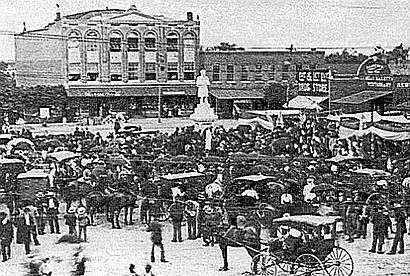Dutchy (statue) facts for kids
Quick facts for kids "Dutchy" |
|
|---|---|

Unveiling of the statue in 1898
|
|
| Artist | Arthur Beter |
| Completion date | July 15, 1898 |
| Medium | Granite |
| Subject | Confederate soldier |
| Dimensions | 210 cm (7 ft) |
| Location | Elberton Granite Museum and Exhibit, Elberton, Georgia |
"Dutchy" is the nickname for a Confederate soldier statue in Elberton, Georgia. It was first shown to the public in 1898. People did not like its design, so in 1900, townspeople knocked it down and buried it. The statue was later found in 1982. Today, you can see "Dutchy" on display in a local museum.
Contents
History of the "Dutchy" Statue
Elberton, Georgia is a city in north Georgia. It is known as the "Granite Capital of the World." This is because a lot of granite is taken from the ground there. In the late 1890s, people in Elberton wanted to show off their granite industry. They also wanted to remember the Confederate soldiers from the American Civil War. So, they decided to have a Confederate monument made.
Many other towns in the Southern United States were also putting up statues like this. They wanted to honor the Confederate side of the war. A sculptor named Arthur Beter was chosen to create the monument. We don't know much about Beter. He was an immigrant to the United States, possibly from Germany or Italy. The granite for the statue was given by Nathanael Long. He was a local doctor and businessman. He donated it because the Women's Confederate Memorial Society asked him to.
Unveiling and Early Criticism
Beter's statue was shown to the public on July 15, 1898. It was a 7 feet (2.1 m) tall statue of a Confederate soldier. It stood on top of a 22 feet (6.7 m) tall pedestal. The statue was placed in Elberton's town square, called Sutton Square. This statue was special because it was the first one carved from Elberton granite. Elberton later became a major place for making granite monuments.
Right from the start, people did not like how the statue looked. A story says that Beter had never seen a Confederate soldier. So, the statue showed a soldier wearing a Union Army uniform. It also had a kepi, which is a type of hat. In 1945, an article in the Atlanta Constitution newspaper said the statue had a "foreign helmet and decidedly northern dress." People also said the statue looked like "a cross between a Pennsylvania Dutchman and a hippopotamus." Soon after, the statue got its famous nickname, "Dutchy." Arthur Beter left Elberton shortly after the statue was unveiled.
Why "Dutchy" Was Removed
On the morning of August 14, 1900, some townspeople took action. This included some Confederate veterans. They were upset because the statue looked like a Union soldier. They pulled the statue down from its pedestal. The next day, they buried the statue in the square. It was placed face-down. The statue was very heavy, weighing about 3,000 pounds (1,400 kg). This might be why they buried it instead of moving it somewhere else. After "Dutchy" was removed, a tin statue of a Confederate soldier was put up in its place.
Finding "Dutchy" Again
In April 1982, "Dutchy" was dug up. This was part of a project by the Elberton Granite Association. The statue was found to be in good condition. It was cleaned at a local car wash. Scenes of the statue being found and cleaned were shown on the TV show Mysteries at the Museum. After this, the statue was put on display. You can now see "Dutchy" at the Elberton Granite Museum and Exhibit.

